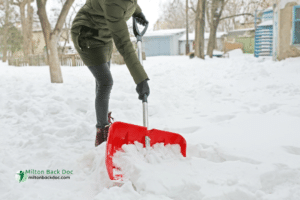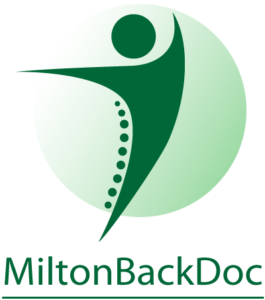A snow-covered landscape looks beautiful but when we hear the words “heavy snowfall warning” one of the first things that comes to mind is the daunting task of snow shoveling, and the aches and pains that come with it. Although snow shoveling can be a great way to get a workout in for the day, if not done correctly it can lead to multiple musculoskeletal injuries. As healthcare professionals, we see many injuries caused due to shoveling, like back pain, shoulder aches and wrist injuries, all caused due to improper shoveling techniques.

Here are some common mistakes people make while shoveling, and tips from a Physiotherapist to prevent unnecessary injuries:
Excessive or repetitive twisting of the spine while lifting:
While shoveling we tend to twist our bodies to throw the snow onto the side. This excessive repeated twisting however can lead to muscle spasms in the back, strains and even herniated discs.
Physiotherapist tip – Instead of twisting from the back to throw the snow, try to push as much snow out of the way onto the side and pivot the whole body in the direction which you want to throw it in.
Lifting from your back:
A very common habit is bending down from the back to lift the snow before throwing it off to the side. This causes a lot of stress on the back muscles leading to soreness and strains.
Physiotherapist tip – While lifting snow onto your shovel, ensure that you brace your core and bend from you knees to squat down instead for bending directly from the back. This will reduce the amount of load transmitted onto your back muscles thus preventing you from getting injured.
Not taking frequent breaks:
A common tendency while shoveling is powering through without taking breaks in order to get the job done quickly. However, this causes excessive fatigue to the muscles and keeps them in a tense and contracted state. This then causes fatigue, soreness and muscle aches, leading to an increased potential for muscle strains.
Physiotherapist tip – Ensure that you shovel in intervals and keep taking breaks in between. Shovel smaller sections at a time and allow your body to recover so as to reduce fatigue. This is a very important tip to follow especially for people who are already suffering from existing injuries.
Shoveling without warming up:
Shoveling is a vigorous physical activity and going into it without a warmup means that you will be working and stressing muscles which are already tight. This reduces the muscles’ contractile function and increases the chance of injuries and strains.
Physiotherapist tip – Do a quick warm up which involves stretching out the muscles of the back, legs and shoulders to increase the blood circulation in those areas. This will in turn improve the muscles’ flexibility and ability to contract, thus reducing your chance of getting injured.
Using the wrong shovel:
Using a shovel that is too big or too small will lead to an increased stress on your body and muscles. Although a big shovel is great for heavy snow, it will also lead to an increased weight which you have to carry, and if your muscles are not trained for such heavy loads it can lead to various injuries.
Physiotherapist tip – Ensure that you are using a shovel that is suitable for your body type and built ergonomically so as to prevent increased load on your body and muscles. An appropriate size shovel should only carry the amount of snow you can comfortably lift. Alternatively, using a standard sized shovel but ensuring you are not overloading the shovel will also do the trick!
If you would like more advice on shoveling safely or are looking for a stretching or strengthening program to support your activities of daily living, our physiotherapists at Milton Back Doc can help. Call us to learn more.


